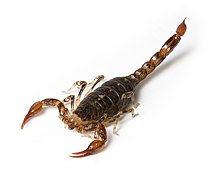Cercophonius squama
| Cercophonius squama | |
|---|---|

| |
| Scientific classification | |
| Domain: | Eukaryota |
| Kingdom: | Animalia |
| Phylum: | Arthropoda |
| Subphylum: | Chelicerata |
| Class: | Arachnida |
| Order: | Scorpiones |
| Family: | Bothriuridae |
| Genus: | Cercophonius |
| Species: | C. squama
|
| Binomial name | |
| Cercophonius squama (Gervais, 1844)
| |
Cercophonius squama, commonly known as the forest scorpion or wood scorpion, is a scorpion native to south-eastern Australia. It is typically around 25–40 mm (0.98–1.57 in) long.[1] Its colour consists of different shades of brown.
Description[edit]
The body is creamy yellow to orange-brown with dark brown variegations.[2] The legs are yellow with some dark brown pigment.[2]
Distribution and habitat[edit]

Cercophonius squama is found in South Australia, Victoria, New South Wales, the ACT and Tasmania. It is the only scorpion found in Tasmania.[3]
Behaviour[edit]
They have been proven to be slightly defensive, nocturnal—like most scorpions—and sedentary, meaning that it is highly unlikely for them to migrate when there are extreme environmental changes. Accustomed to a wetter climate, these scorpions can dig shallower or deeper burrows, depending on the situation, to avoid environmental extremes for several months.[4]
Breeding[edit]
Insemination occurs before winter and birth typically occurs during summer.[3] Females give birth to 20-30 live young over a period of several hours.[3] The young are white and soft-bodied at birth.[3] Females have been observed selectively eating some of the young but the trigger is not known.[3] It takes approximately two weeks for the exoskeleton to completely form for newborns.[3]
References[edit]
- ^ "Southern or Wood Scorpion Cercophonius squama". Museum Victoria. Archived from the original on 23 April 2017. Retrieved 11 October 2008.
- ^ a b Clinical Toxinology Resources - Cercophonius squama, University of Adelaide
- ^ a b c d e f Abraham Miller - Cryptically beautiful: surprising observations of the scorpion Cercophonius squama
- ^ Margules, C. R.; Milkovits, G. A.; Smith, G. T. (1994). "Contrasting Effects of Habitat Fragmentation on the Scorpion Cercophonius Squama and an Amphipod". Ecology. 75 (7): 2033–2042. doi:10.2307/1941608. ISSN 0012-9658.
